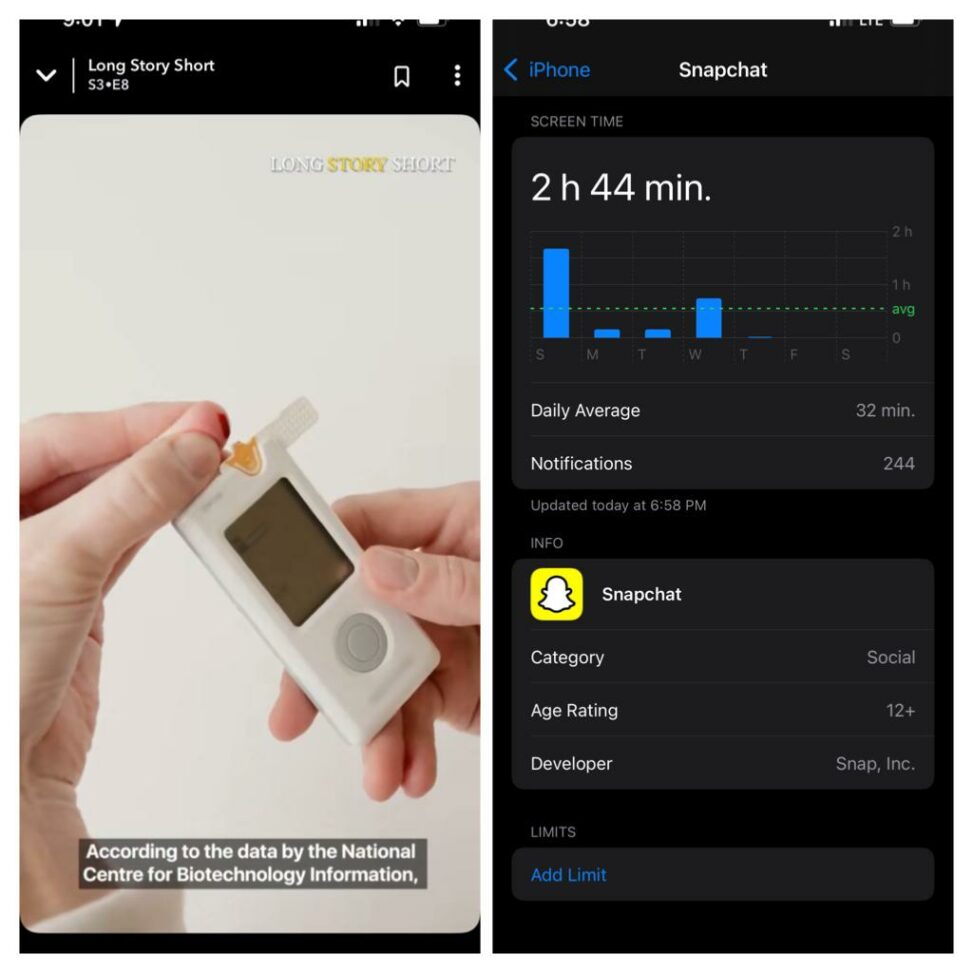Image Attribution: “SNS Analysis|| Part A ||Submission” by Komal is licensed under CC BY. (See interactive map)
Komal
October 28th, 2021
VISA 1500 Fall 2021
Terryl Atkins
Assignment #2 Part A
Users’ lives are recognized to be profoundly influenced by social media sites. Previously, elder generations were known to utilize social media in moderation, but that is changing now. Most of us don’t agree with this fact, but deep down we all know it’s true.
I used to be a social media addict, averaging 13-15 hours of screen usage each day, which has now dropped to 4-5 hours. Snapchat is my most used social media app, with average screentime of 2:30 hours, followed by Instagram and WhatsApp. I’ve received 257 Snapchats, along with texts and calls, 10 Instagram messages, and more than 20 WhatsApp messages in the last five days. In comparison to Instagram and WhatsApp, I shared more content on Snapchat. Because I live so far away from my family, I rely on social media to keep in touch. Snapchat is used for both fun and communication, while WhatsApp is only used for sharing workplace information. On these apps, I don’t do much creating or editing media.
WhatsApp is basically designed for communication purposes and allows users to share a WhatsApp status for 24hours leading to fewer chances for people to judge others and also providing privacy better than any other platform. The only drawback is you need to have the contact numbers of people you want to add. Otherwise, there are no such cons of using WhatsApp on regular basis.
On Snapchat people can send photos to other users that will expire in one to ten seconds. There are an estimated 100 million daily active users of Snapchat, about 70% of whom are women (Smith, 2015, p.1). Wagner (2014) found that more than 77% of college students use Snapchat at least once per day. Snapchat was mostly used for creativity (73 percent), followed by keeping in touch (27%). Snapchat is easier to use than texting, according to about a quarter of college students (23 %). Snapchat conversations were shown to be more pleasurable – and connected with a higher good mood – than other communication methods.
Furthermore, users compared Snapchat to face-to-face engagement and reported paying more attention to Snapchat content than archived content, which could lead to higher emotional rewards. Snapchat was perceived as a lightweight channel for sharing impromptu events with trusted ties, rather than a platform for sharing or viewing images, which has led to comparatively low self-esteem issues as compared to Instagram. Because Instagram influencers tend to disclose more of their opulent and joyful lives, which are not at all true, resulting in a higher level of insecurity and lack of confidence among followers and regular users on the platform. Snapchat has many positive impacts, such as allowing users to share everyday experiences with close friends and reducing self-presentation concerns.
Since there are two sides to a coin, similarly there are two sides to using Social Networking Sites. Snapchat interactions were linked to weaker social support than other platforms. The use of all these sites has been affecting our growing generation a lot. Teenagers like using online social networks(OSNs), but they may be unable to interpret commercial messages or protect themselves from dangerous promotions, presenting ethical concerns. The use of OSNs by teenagers aids the development of a social skill known as the theory of mind (ToM), which aids in the interpretation of advertisements and the detection of deceptive content. ToM opposes youth materialism, which can be encouraged by unethical marketing, proving ToM’s usefulness in minimizing the negative effects of unethical marketing. Furthermore, OSNs have altered how teenagers acquire ToM, such that they now play a primary role in ToM development, replacing offline interactions (i.e., offline friendship quantity/quality).
My habits and behavior have changed dramatically as a result of these apps, as I used to spend most of my day online, and my jokes and routine were all centered on what I saw. I’ve started to rely on them for nearly everything, including news, health advice, and so on. One of the most advantageous things for me is that through Snapchat, I learned about all of the new diabetic equipment and advice, as well as the sensors that I now use.
References:
- Elodie Gentina, Rui Chen, Zhiyong Yang. (2021, January). Development of theory of mind on online social networks: Evidence from Facebook, Twitter, Instagram, and Snapchat, Journal of Business Research, Retrieved from: https://www.sciencedirect.com/science/article/pii/S0148296320301557
- Bayer, Joseph & Ellison, Nicole & Schoenebeck, Sarita & Falk, Emily. (2016). Sharing the Small Moments: Ephemeral Social Interaction on Snapchat. Information Communication and Society. 19. 956-977. 10.1080/1369118X.2015.1084349.
- Smith, C. (2015, Aug. 13). By the Numbers: 60 Amazing Snapchat Statistics. DMR. Mobile Marketing. Retrieved from http://expandedramblings.com/index.php/snapchat-statistics/
- Wagner, K. (2014, February 14). College Students Use Snapchats Daily. Retrieved from http://mashable.com/2014/02/24/snapchat-studycollege-students/
